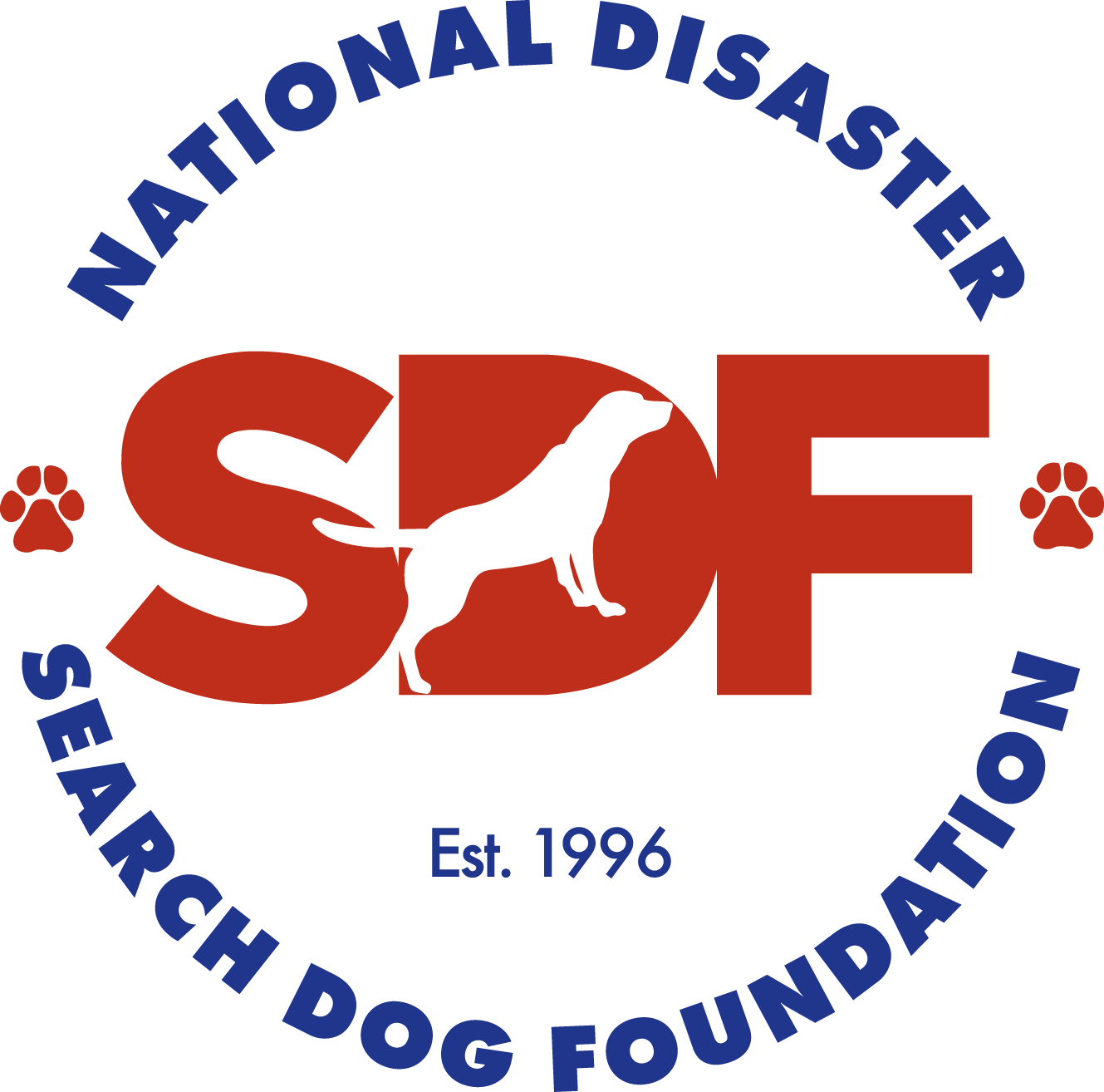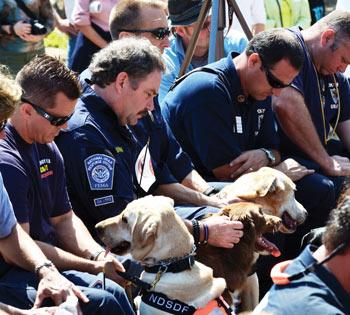The Santa Ynez Valley Journal
The dark shadow of aftermath looms heavy in the morning air as search dogs pace, eager to begin the task of converting hope into promise, of finding life below the rubble.
It can be anywhere, anytime.
Not just in the wake of terror in New York City, or in the sweltering heat and salty waters clinging to the streets of New Orleans in August 2005, or in quake-ravaged Port au Prince, Haiti, or Japan earlier this year, when the call comes, the search dog and handler teams respond. Teams are trained here in California; many of the canines found by Los Olivos’ own Heidi Miller.
Last Sunday marked the opening of the first phase of the National Search Dog Foundation’s (SDF) new quarters in Santa Paula. In a day-long event commemorating the 349 firefighters who died in the Sept. 11 attack, they also honored the 13 handlers who served at ground zero 10 years ago and all the organization’s search dogs “who have passed over the rainbow bridge,” said founder and CNN hero Wilma Melville.
Abby, the last living SDF dog who served in the aftermath of the terror attack, and her handler, Debbie Tosch, were on hand. Now a senior citizen, Abby suffers from weakening muscles and moves slowly through the day, her tail wagging a steady beat at the sound of her partner’s voice.
In the last 10 years, SDF trained 131 canine disaster search teams, deployed in seven states and Tijuana, Mexico, who responded to 81 disasters both nationally and internationally. Nearly every one of the dogs SDF trains is rescued from a shelter. Only a few are donated by families who found their pets too hard to handle for all the reasons that make them good search dogs. No dogs are bred by SDF, nor do they encourage it.
During hayride tours of the site, Steve Dowty, the project’s architect, noted that the facility will be built in phases. It will be a green building project, with no liquid landfill, said SearchDogsUSA President David Kaplan in the joint presentation. The second annual Remembrance Day marked the opening of the welcome center, for which ground was broken last year.
Until the training center is complete, the dogs will continue to be trained in Gilroy. “A very complicated project, but so far so good,” says Dowty.
Nearly all of the services are provided to fire departments free of charge by SDF. They are working toward establishing an endowment, so that in the future they may be able to cover some travel costs as well. It is an expensive proposition. The average cost to train a dog/handler set is $10,000, says Miller. A donor can sponsor one for that amount, and receive in exchange the chance to meet the team, follow their career and know they have helped their community. And while donations are always needed, the Remembrance Day was not a fundraising event.
“I was lucky enough to get picked,” said Patty Craft, a firefighter who came to the event from Texas with her dog named Hula. A great deal of care goes into selecting both the human and canine components of each team. “When they picked me to work with her, the first thing I said was, ‘What is this?'” laughs Craft of the unusual Leopard Catahoula selected to be her partner. Hula just received FEMA certification, so the two haven’t been deployed yet, but living in tornado alley, it’s only a matter of time.
Visitors are treated to a demonstration of the skills the dogs learn and the methods used to teach them. The center’s training methods are being copied by other trainers, but this they see as a compliment, says Kaplan. For the dogs, it is a game they are happy to play. Eager and alert, losing focus or being distracted by cameras, crowds or the barking of other dogs isn’t an issue.
Tucker runs through his appointed task of walking up and then down the teeter-totter, and then leaps on to the next obstacle before his handler can signal him to stop. Spectators laugh as he stands motionless, his paws in perfect alignment on 2-by-4 planks set several feet off the ground. Tucker looks over his shoulder at his handler, as if to say “Stop, really” but on the signal to return, he does, without hesitation.
Tucker’s confidence comes from both an innate awareness of where all four of his paws are at any given time—a quality the canine recruiters look for—and from lots of practice. Dogs learn to crawl through tunnels, climb debris piles and even climb ladders—up, down and bridged across obstacles, says Pluis Davern, the lead canine trainer. Not all dogs who enter the program graduate, but no dog rescued by SDF ever ends up back in the shelter. They make a lifelong commitment to each dog, no matter what. The canines are taught to walk on the unstable and moving footing often found at disaster sites by placing planks atop two tipped barrels. As the dogs jump up to cross, the whole set-up moves. Un-phased, they simply adjust their center of gravity, gingerly make their way across the obstacle. Leaping off the far end, they dash excitedly back to their partners.
Unlike agility, speed isn’t everything. Safety is everything. “You can’t just get another dog if one is injured,” explains Davern. “If a dog is uncertain of his footing, he can’t use his nose,” and ultimately it is the dog’s nose that will find life in the depths of the rubble. “They have to get up on things that are moving and things that are high.”
The dogs learn to take direction from handlers—right, left, back. They can be guided to where the human partner thinks the search should go. On this date, when they demonstrate their skills on the rubble pile, their clues are limited to smell. “You are going to see dogs make mistakes, and the handler turn that into a training session,” says Davern.
But rare was the miscommunication between partners, and never did a dog waiver in their attention or desire to comply. A simple, short blow of a whistle brings the dog to an instantaneous stop. Frozen in place, eyes transfixed—not even a tail wags as they wait for the handler to direct them. Once released, the dog bolts back into action.
For their efforts, the dogs are rewarded with a quick game of tug with a favorite toy, rather than an edible treat. “They are a very cheap date,” quips Davern. The nature of disaster sites, where gloves are worn by handlers and dogs for their own safety are trained not to eat anything, a toy on the end of a rope is a happy choice for all. “I walk around with a perpetual stain on my back from dirt and slobber,” Craft teases as she wrestles the toy away from her eager teammate and slips it back into the pocket, where it is stored for easy access.
Hula, like all the others dogs, goes with her handler to the fire station each day and home again at night. She learned the routine of both well. As soon as the alarm sounds at the station, Hula trots to her kennel where she knows to stay until the firefighters return.
When training the dogs on mock rubble piles, they keep changing things up because the dogs “figure it out and get bored,” say Kaplan. Handlers take turns hiding inside barrels under the debris pile, tucked inside sheds or secluded safely in crevasses carefully made from stacked bales of hay so the dogs can take turns finding them. Without visual clues, the dogs are sent searching one at a time, enthusiasm barely kept in check.
Tails wag when the dogs sense they are close. In the case of Salsa, she manages to wag her entire back half, barking enthusiastically when she locates the hidden human. It’s a game the dogs never tire of and the handlers hope need never be more than that. But there is comfort in knowing that when disaster hits, they are ready. In a real-world setting, the dogs’ feet are quickly checked for injury and they are given water before being sent back out. This ritual helps insure the dogs’ safety and clues them in that their job is not yet done, says Davern.
The day ends with a touching farewell to those dogs whose jobs are complete, who have left their lives, fond memories and well-earned legacies behind. And while they are now at rest, the staff and volunteers at SDF still have much to do. For information on how you can help, visit searchdogfoundation.org.


